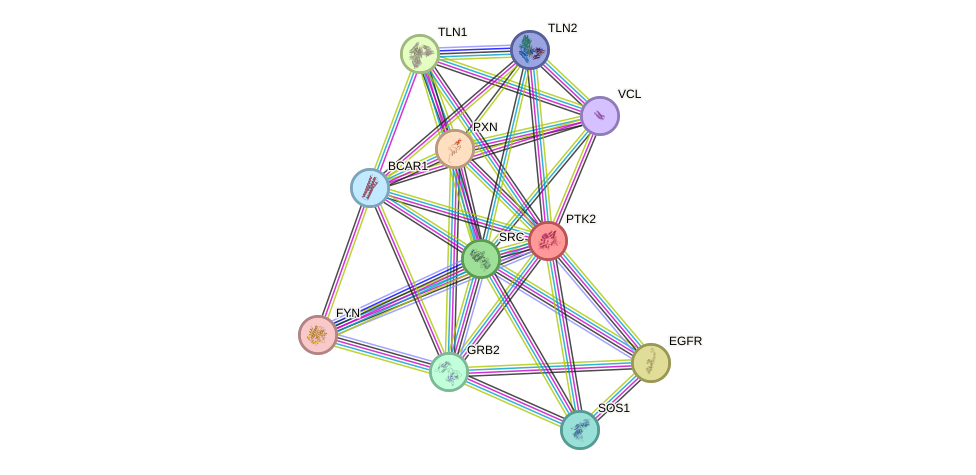GenAge entry for PTK2 (Homo sapiens)
Gene name (HAGRID: 166)
- HGNC symbol
- PTK2
- Aliases
- FAK; FADK; FAK1; PPP1R71
- Common name
- protein tyrosine kinase 2
Potential relevance to the human ageing process
- Main reason for selection
- Entry selected based on evidence showing that the gene product to be a target of genes previously linked to ageing
- Description
PTK2, also known as focal adhesion kinase (FAK), plays a role in the signal transduction of a number of pathways such as MAPK signalling, apoptosis, cellular proliferation, and cellular senescence [998]. PTK2 deletion in the epidermis of mice suppresses tumour formation [1717]. Its role, if any, in human ageing is unknown, but PTK2 could potentially be involved in downstream signalling cascades related to ageing.
Cytogenetic information
- Cytogenetic band
- 8q24.3
- Location
- 140,658,382 bp to 141,001,313 bp
- Orientation
- Minus strand
Protein information
- Gene Ontology
-
Process: GO:0000165; MAPK cascade
GO:0000226; microtubule cytoskeleton organization
GO:0001525; angiogenesis
GO:0001570; vasculogenesis
GO:0001764; neuron migration
GO:0001890; placenta development
GO:0001932; regulation of protein phosphorylation
GO:0001934; positive regulation of protein phosphorylation
GO:0003007; heart morphogenesis
GO:0006921; cellular component disassembly involved in execution phase of apoptosis
GO:0007172; signal complex assembly
GO:0007173; epidermal growth factor receptor signaling pathway
GO:0007179; transforming growth factor beta receptor signaling pathway
GO:0007229; integrin-mediated signaling pathway
GO:0007411; axon guidance
GO:0008284; positive regulation of cell proliferation
GO:0008360; regulation of cell shape
GO:0009790; embryo development
GO:0010594; regulation of endothelial cell migration
GO:0010632; regulation of epithelial cell migration
GO:0014068; positive regulation of phosphatidylinositol 3-kinase signaling
GO:0018108; peptidyl-tyrosine phosphorylation
GO:0021955; central nervous system neuron axonogenesis
GO:0022408; negative regulation of cell-cell adhesion
GO:0030010; establishment of cell polarity
GO:0030198; extracellular matrix organization
GO:0030335; positive regulation of cell migration
GO:0033628; regulation of cell adhesion mediated by integrin
GO:0038007; netrin-activated signaling pathway
GO:0038083; peptidyl-tyrosine autophosphorylation
GO:0038096; Fc-gamma receptor signaling pathway involved in phagocytosis
GO:0040023; establishment of nucleus localization
GO:0042127; regulation of cell proliferation
GO:0043066; negative regulation of apoptotic process
GO:0043087; regulation of GTPase activity
GO:0043542; endothelial cell migration
GO:0043547; positive regulation of GTPase activity
GO:0043552; positive regulation of phosphatidylinositol 3-kinase activity
GO:0045087; innate immune response
GO:0045667; regulation of osteoblast differentiation
GO:0045860; positive regulation of protein kinase activity
GO:0046621; negative regulation of organ growth
GO:0046777; protein autophosphorylation
GO:0048010; vascular endothelial growth factor receptor signaling pathway
GO:0048013; ephrin receptor signaling pathway
GO:0048870; cell motility
GO:0050771; negative regulation of axonogenesis
GO:0051493; regulation of cytoskeleton organization
GO:0051893; regulation of focal adhesion assembly
GO:0051897; positive regulation of protein kinase B signaling
GO:0051964; negative regulation of synapse assembly
GO:0060396; growth hormone receptor signaling pathway
GO:1900024; regulation of substrate adhesion-dependent cell spreading
GO:2000060; positive regulation of protein ubiquitination involved in ubiquitin-dependent protein catabolic process
GO:2000811; negative regulation of anoikis
Cellular component: GO:0001725; stress fiber
GO:0005634; nucleus
GO:0005737; cytoplasm
GO:0005815; microtubule organizing center
GO:0005829; cytosol
GO:0005856; cytoskeleton
GO:0005886; plasma membrane
GO:0005925; focal adhesion
GO:0005938; cell cortex
GO:0016324; apical plasma membrane
GO:0030027; lamellipodium
GO:0031234; extrinsic component of cytoplasmic side of plasma membrane
Hide GO termsFunction: GO:0003779; actin binding
GO:0004672; protein kinase activity
GO:0004713; protein tyrosine kinase activity
GO:0004715; non-membrane spanning protein tyrosine kinase activity
GO:0004871; signal transducer activity
GO:0005088; Ras guanyl-nucleotide exchange factor activity
GO:0005102; receptor binding
GO:0005515; protein binding
GO:0005524; ATP binding
GO:0008432; JUN kinase binding
GO:0019901; protein kinase binding
GO:0042169; SH2 domain binding
Protein interactions and network
- Protein-protein interacting partners in GenAge
- SHC1, TP53, IGF1R, PTPN11, STAT3, IRS1, EGFR, ERBB2, RET, PARP1, PTEN, HSP90AA1, GSK3B, GRB2, APP, PTK2, PIK3R1, MDM2, JAK2, PPP1CA, STUB1, SOCS2
- STRING interaction network
Retrieve sequences for PTK2
Homologs in model organisms
In other databases
- CellAge
- This gene is present as PTK2

